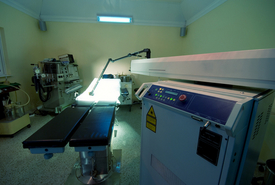 In June of 1989, Gholam A. Peyman, MD, received a patent for a procedure in which surgeons create a corneal flap, and then ablate underlying corneal tissue to correct refractive errors. The procedure, now known as LASIK, was subject to exhaustive clinical testing for the next decade. In 1999, ophthalmic excimer lasers were FDA approved for use in LASIK surgery. Since then, it has become the most popular form of refractive surgery in the United States.
In June of 1989, Gholam A. Peyman, MD, received a patent for a procedure in which surgeons create a corneal flap, and then ablate underlying corneal tissue to correct refractive errors. The procedure, now known as LASIK, was subject to exhaustive clinical testing for the next decade. In 1999, ophthalmic excimer lasers were FDA approved for use in LASIK surgery. Since then, it has become the most popular form of refractive surgery in the United States.
Although Peyman received the first U.S. patent for LASIK, there are a number of other experts that played a role in the development of the procedure.
Development of the Microkeratome
Spanish ophthalmologist Jose Barraquer was living in Bogota, Colombia when he developed the first microkeratome in the 1950s. The microkeratome is a bladed instrument that is used to create thin flaps in the cornea. Barraquer used the microkeratome in a procedure he called Keratomileusis, which was designed to correct refractive errors. During the procedure, a layer of the patient’s corneal tissue was removed; the layer was frozen and reshaped in a cryolathe, and then re-attached to the cornea. Unfortunately, Barraquer’s Keratomileusis procedure had an important drawback: the freezing process damaged the corneal tissue. As such, the Keratomileusis procedure did not gain widespread acceptance among eye surgeons.
Development of the Excimer Laser and PRK
Excimer lasers were developed in the 1970s, and their initial widespread use was in the production of microelectronic devices. In 1982, IBM employee Rangaswamy Srinivasin discovered that excimer lasers could ablate living tissue without causing heat damage to the surrounding areas. Stephen L. Trokel, MD, an ophthalmologist working out of Columbia University, began researching the use of the excimer laser to modify the curvature of the cornea in the correction of refractive errors. By 1983, Trokel and Srinivasin were running excimer laser experiments on cow eyes.
Trokel went on to patent the excimer laser for use in laser vision correction, and is a co-founder of VISX, which produces excimer lasers and custom laser vision correction systems. In 1988, Dr. Marguerite B. McDonald performed the world’s first PRK laser vision correction procedure on the live human eye. In 1995, an excimer laser was FDA-approved for use in PRK surgery.
The LASIK Patent
Peyman received his LASIK patent in 1989. One year later, Dr. Ioannis G. Pallikaris performed the first ever LASIK surgery, using Barraquer’s microkeratome and an excimer laser. Early LASIK procedures were successful, and patients experienced fewer side effects than PRK patients.
LASIK FDA Approval
The excimer laser was approved for use in LASIK procedures in 1999. Since then, experts continue to refine the procedure.
- Intralase® laser:The Intralase® femtosecond laser was approved by the FDA in 2001. The Intralase® replaces use of the microkeratome during LASIK surgery. Studies have shown that the Intralase® greatly reduces the occurrence of flap complications after surgery.
- Wavefront technology:Custom LASIK systems incorporate the use of wavefront mapping technology to more accurately diagnose refractive errors. After the wavefront map is created, the data is used to guide the excimer laser as it reshapes the cornea. The FDA has approved a number of custom LASIK systems, including the VISX CustomVue™ and Allegretto Wave™ systems, which I use at our Virginia LASIK practice.
If you are interested in undergoing LASIK surgery, contact my practice today.



